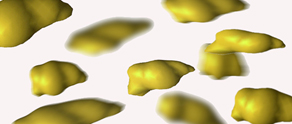

The Gods are dead but they have died from laughing, on hearing one God claim to be the only one ... There is no event, no phenomenon, word or thought which does not have a multiple sense.(1)
The recent rise of interest in animation within architecture operates in conjunction with a field of contemporary work in which we find phenomena such as buildings involving explicit movement, generative processes involving animation software and the proprioceptive sways of curvilinearity.(2) The horizon squirms with overt gesticulations. Here, architecture becomes an animated diagrammatics madly throwing about its arms in a sign language of qualitative affect: a dancing to the beat of the animate. Turning to Nietzche's concept of the 'will to power' has been a way through which to articulate that which I see as the substance within this architectural turn to animation. This substance is built up through a capacity for supple transformations that are poignantly politic and of particular relevance to the very animated forms of power that are moulding contemporary political landscapes.
I explore this here through three specific works, each of which has been produced in association with the School of Architecture and Design at RMIT University, Melbourne. These are the work of Tom Kovac, a final year thesis project by student Jessica Lynch and an exploratory project from my own research. These have been bought together for the ways in which they engage very different techniques of animation and the divergent paths through which they tend toward the production of the animate. Each brings forward issues regarding how something is made or emerges through a capacity to accept and synthesise a diversity of contingencies within its fabric. This is a core condition of the will to animation; the 'unity' of this will only exists through a dynamic synthesis of many.
A thing is sometimes this, sometimes that, sometimes something more complicated - depending on the forces (the gods) which take possession of it. (3)
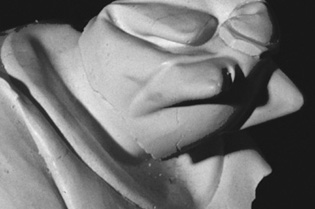

'The Turn On', Paster Casts, Pia Ednie-Brown.
The first example is a series of casts that emerged through my experiments with latex and plaster. Each one of the series is the product of a deformation of the same mould. They were made through pouring liquid plaster into the latex mould of a shower tap. The act of making involved a kind of puppeteering act in which the elastic moulds were suspended with string, positioned with wire and held down with tape under chairs, in boxes, off coat hangers - whatever was at hand. Pouring in the plaster was always a somewhat precarious operation and could never be completely controlled. The latex stretched and deformed with the weight of the fluid plaster, particularly as the makeshift supports fell away or shifted. The resulting casts arose from the coalescing involutions of a myriad of variable relations all struck into an accord: form extracted from dynamic interactions, falling into one another in a collaborative agreement with a responsively overarching skin. This skin becomes a dominant force of willingness: a will to formal tendency but also a willingness to remain sensitive to the materials and conditions with which it engages. The overarching definition of the skin held the capacity of deformation without falling apart and transform without entirely loosing recognition. This process diagrams the principle of the will to animation.
What becomes important is not simply the emergent form than an emergent 'texture', where texture is defined as a tendency of variation. A flexible refrain; a variable consistency. This shift from form to texture involves the transformation of 'materiality' from a reduction to the forms and qualities of visible material to a more extensive and inclusive materiality of affect (4), wherein the animate (virtuality) becomes palpable.
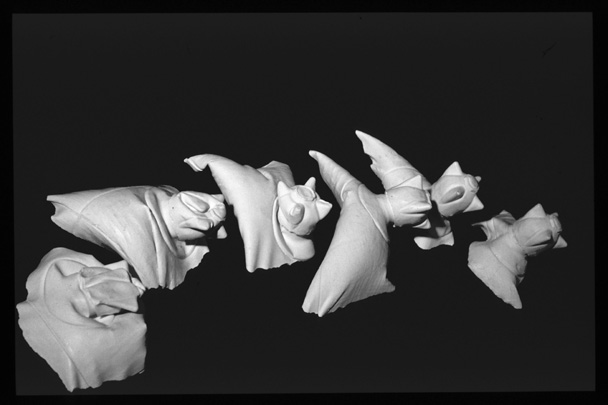
'The Turn On', Paster Casts, Pia Ednie-Brown.
The 'character-like' qualities of the casts act through a sense that every modulation operates in accord with every other; all swept into a spring of suspended animation. There is a lightness or levity that emerges through this intertwinement or the fall of conditions and signs into one another. One of the most significant moves made in the shift from the moulded metal shower tap to the plaster casts is the escape from the shadow of the rigid mould. The moulds which shape the taps in our bathrooms are not endowed with a flexibility to be affected by the material they set into shape (they have to remain unaffected in order to produce another just the same and to ensure that it will function as planned).
The processual assembly line through which standardised elements are formed has a very definite consistency of action but this process strives to remain consistently the same rather than differentially consistent. Standardised elements are no more or less expressive of the consistency of their formation than more flexible ones. What becomes most important is the capacity for the dominant force (the mould) to be affected by that with which it engages: "In order for the will to power to be able to manifest itself it needs to perceive the things its sees and feel the approach of what is assimilable to it." (5) Standardised formations speak most emphatically of a distant regime, bearing a heavy shadow of the rigidity for which they act as a register. The viscerality of duration or the force of expression is both violently and subtly suppressed. Alternatively, where the primary register of variable relations (the mould) or that which holds a primary power to affect, retains the power to be affected, it acts to affirm rather than suppress the virtuality that stirs within in the encounters in the act of emergence. "To affirm is not to take responsibility for, to take on the burden of what is, but to release, to set free what lives. To affirm is to unburden: not to load life with the weight of higher values, but to create new values which are those of life, which make life light and active."(6) Escaping from lofty weights through the capacity "to laugh, to play and to dance."(7)
The politics of the rigid mould is to render that which falls under its arch of influence as submissive and servile. Deviation and deformation becomes aberrant, invalid, illegal. The politics of the flexible mould is one of an affirmation of the force of expression in its multiplicity.
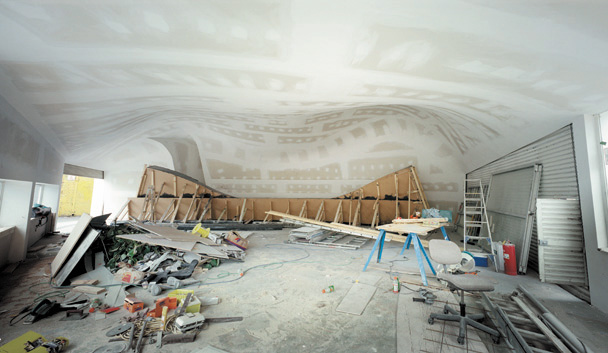
Glow, Tom Kovac, Melbourne, Australia. Photography John Gollings.
The politics of these casts provided a way through which to understand the practice of Tom Kovac. Making sense of his work is a manifold operation mainly because it is so many: so many moments folded into the one, so many trajectories synthesised within the surface, so many sounds when nothing seems to be said. The work doesn't emerge though stating a position or staking out its place within a cognitive territory or processual strategy through which it will move. Rather, it shifts through different territories with supple modulations, transforming in relation to the forces it encounters while holding together through the flexible integrity of its tendencies of variation.The attention Kovac's architecture has sustained is linked with its capacity to move with the flows of the current; to dance around the props of the proper. The supple synthesis at work in Kovac's practice is not contained in the expressed physical actualisations, but is also inseparable from them. The sense that a singular quality of force is gathered through the overtly smooth interrelation of elements is very powerful - both within each project and, variably, across the body of work. Windows stretch away, as much as possible, from being distinct frames, always slipping into surfaces which encounter minimal interruption; floors become part of an enveloping surface such that the ground swirls up over ones head; colour is uncompromisingly focussed (all white, all red - any additional elements: grey or black); detailing operates to minimise discontinuities; furniture is peeled back into singular gestures such that it can enter into, rather than disrupt, the flow through which the architecture is swept. Everything is, as much as possible, moved into a differential continuity of variation.
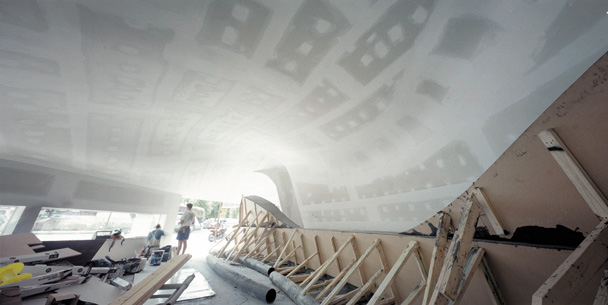
Glow, Tom Kovac, Melbourne, Australia. Photography John Gollings.
This is what we can directly witness in an encounter of his work, but there is an infinitely more expansive terrain of forces that can never be seen and can only be sensed (the determined passion, site conditions, economics and sponsorship deals, conversations, the turbulence of travel...). All is choreographed into gyrating concert and coalesced through the force of a fiercely focussed, flexible expression: into the force of a fiercely focussed "differential mutual emergence." A diagram of the process of becoming.(9)
These gestural sweeps operate with such flexible determination (rather than rigid determinism) that operations of materiality make an emphatic move through the assemblage of individual materials into a materiality of affect.(10) The animate made palpable. A pulse of sensation passes through the architectural body, translating and synthesising stimuli in choreographically transforming it into a wave of vibrations, rhythms, contractions and expansions; "the capacity for being affected is not necessarily a passivity but an affectivity, a sensibility, a sensation."(11)

Ikon Tower, Tom Kovac. Digital Imaging, Jonathan Duckworth.
The coincidence of Kovac's work and the deformed tap casts lies in the common departure from rigid moulds of instrumentality. This can be counterpoised with the critical tradition of the American schools which has operated through a privileging of intellectual structures that, in order to be critical, survey the process of design from a distance. When the dominant force, or the primary limits of process, form through a foregrounding of intellectual structures, the processual mould is more or less characterised by rigidity, representational distance and formalised relationships. This approach is ingrained in the work of Peter Eisenman, where he insists on distance in order to avoid the danger of impotence through absorption into dominant flows of power. As he writes in his recent book, Diagram Diaries,:
One of the pitfalls of modern architecture was that it attempted to express the zeitgeist in its being rather than displacing it. Ultimately, modern architecture was absorbed by global capital, precisely because the ideology of modernism became normal and generic rather than critical ... The possibility of such a global capital today is a manifestation of the failure of modernism to transgress and displace its own space. In its attempt to manifest that zeitgeist, modern architecture lost the possibility for displacement and presentness …(12)
If it can said, as I did above, that Kovac's work 'moves with the flows of the current', then given the terms that Eisenman lays out, this might cast it down the pit into which modernist architecture fell through its expression of the zeitgeist. But his is not an expression of the zietgiest, it is an emergence that casts its skin through a supple interaction with the zeitgiest, or the pulse of the moment. Where Eisenman locates the two possibilities of critical displacement or expressive immersion, Kovac operates within a third.
Any historical specificity offers its own forms of danger. We are always negotiating some assemblage of forces which act as dominant regimes and threaten various kinds of violence; some kind of relinquishing of potential. In Gilles Deleuze's paper, Postscript to Societies of Control, he outlines the shift from disciplinary societies to 'societies of control'; to the conditions and logics which contemporaneity seem to offer. He outlines this as a shift of logic: from a disciplinary logic defined by rigid confinements to one of 'control' defined through modulations. This shift can be tracked across the path from shower tap to the plaster cast production, from rigid moulds to flexible ones: "Confinements are moulds, different mouldings, while controls are a modulation, like a self-transmuting moulding continually changing from one moment to the next, or like a sieve whose mesh varies from one point to another."(13) This implies a differently constituted set of dangers, where "a man is no longer a man confined but a man in debt." But, as he wrote, " It's not a question of worrying or of hoping for the best, but of finding new weapons".(14)
Weapons are not things but modes of action. Maintaining ideas of resistance are no longer tenable: the opponent moves too fast and changes shape too often. As forms of power become more animated, negotiating them requires the capacity to transform with nimble acumen; to play when the rules need to be manipulated, to dance around the props of the proper, to laugh when the world becomes heavy. To know how to do what lofty regimes cannot subsume: to laugh, to play and to dance.(16) It becomes an issue of gathering enough force and power of expression within the transformations of the moment to remain at the surface with depth; to not be subsumed by the current or spread too thin, to not be carried along without any power to affect.
Peter Eisenman's book proclaims great faith in the importance of being critical but traces out a curve through which the diagram as an instrument of a critical architecture has been forced, more or less against its will, to succumb to something else. Diagram Diaries moves sequentially through over thirty years of work mapping out the transformations that have occurred through his investigations which, more than anything else, interrogate the possibilities for intensified criticality in architecture. This critical activity, mapped out and produced through diagrams, is understood as an ideological operation. Toward the end of this text, he writes, "I no longer feel compelled to insist upon an ideological sub-structure in my own work. If one looks back on the work, historically, thirty years from now, will it be said that this loss of ideology was a late period, a playing out of an endgame? Or will it be said that this publication marks a new opening to something else, a freeing of the work from an ideological necessity?"(17) The fate of this ideological sub-structure lies in the fate of the diagram, which "has come full circle from the strategies of reading to the tactics of visceral experience. At the same time, the diagram seems to disappear from the built work ... it becomes more or less a virtual entity, rather than being made explicit in the projects. This is because the diagram becomes more of an engine in the projects rather than something which transforms itself into a physical reality."(18) As the diagram disappears both into and out of the projects, this third politics would seem to be the "opening to something else".
This emergence suggests a manner of working that slips between and extends beyond Eisenman's dichotomy of options. This we can find in Kovac's politics of supple, consistently variational skins: skins which are at once sensitive and brutal; constructively politic; playing with the rules. Transformationally determined. Dangerous and vital in their fabricated realities. Within this Nietzschean playfulness "laughter flutters from him like a motely cloud."(19) An imminence of a will to animation. A diagram of the process of becoming.(20)
Actual form is immanence as it has folded out of itself. (21)

Jessica Lynch, Final year thesis project, 'Inverted Landscape', section through site.
Within these politics is a concurrent shift related to identity which is no longer fixed but thoroughly animated. While this is implicit in Kovac's practice it becomes explicit in the final year thesis project of Jessica Lynch who worked with the animation of identity as integral to a political architectural act.
Her project sprung out of a competition brief for a public space with ancillary exhibition areas in the Parliamentary Zone of Canberra. This space was called for in order to mark and celebrate the centenary moment of Australia's Federation of states into a political unity. Operating with a wry humour and a finely tuned attention to delicate absurdities, Jessica set out to transform weighty forms of identity through a series of transformational inversions.

Jessica Lynch, Final year thesis project, 'Inverted Landscape', some of the initial AutoCAD flower models.
Each state of Australia has an emblematic flower. These became delightfully appropriate pickings which she set out to re-arrange, deformationally. From a series of old etchings of these flowers, she modelled them in 3D with AutoCAD where the pastel meshes strangely approximated the fine line work of hand drawn etchings. She initially arranged them into a sequential, animated mutation of one flower into another, such that these icons cinematically federated.

Jessica Lynch, Final year thesis project, 'Inverted Landscape', emblematic flowers of the Australian States morphed into one another.
In realising the potential within this animated morphology but wishing to dodge any implied seamless merger of the states, she carried this into a more complex act where each species was inverted through a rotation of their turning inside out. Here she drew upon the suggestions of E. Jouffret (22) that an object turned inside out is rotated through the fourth dimension. What this offers, as she argued via Duchamp's work relating to the multiplicity of identity and the fourth dimension, is an unleashing of the "potential that we can be everything at once." (23)The various stages of these inversions became the infinite smorgasbord of formations for the variously programmed pavilions that would be scattered across the new public space. During the process of design development, when these drawings were exposed to others, we would hear sighs, moans and gasps of delight which seemed to echo the transformative action of the flowers moving through the stages of rotational inversion.
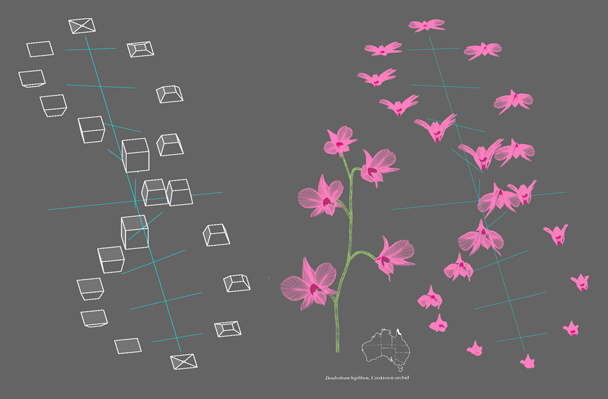
Jessica Lynch, Final year thesis project, 'Inverted Landscape', Rotational inversionof orchid flower through itself with diagram of inversion process.
These twisted flora fell onto the site in accord with a celestial positioning drawn from the location of the stars above the site at the dawn of Australia's Federation. Tall poles pierced each stellar position, becoming primary structural elements for each of the floral pavilions: "like the pins of a giant butterfly collection. Architectural Entomology".(24) Across the flat plane of the flat manicured lawn (so characteristic of Canberra) she laid down an image of a woman published in the Bulletin newspaper in 1899 as a caricature of the emerging about-to-be-federated nation standing in wanton shame as Australian soldiers set out to fight battles for the British Empire. This image, which we came to know as 'Miss Fed' (or misfed), was radically stretched along the primary Parliamentary axis such that it would anamorphically reconstitute into the original from a tourist lookout (through viewing binoculars or those touristic coin operated peep shows of picturesque moments). This "point of hindsight"(25) is positioned at the viewpoint of the surveyor in Marion Mahony's early illustration of the Canberra Master Plan, designed by herself and Walter Burley Griffin. While the identification of this image was retained at this one poignantly hingeful moment, it was thoroughly unrecognisable from any other point of view. This black and white newspaper etching became an inverted mould, carved as an inverse figure out of the ground, becoming a dug-out sculpted terrain that formed an 8 meter wide, 80 meter long axial scar across the lawn. This depression of modulated landform became a vast linking chasm between the pavilions which danced about it's sides.
Jessica's work is thick with cultural signs and densely packed with layers of narrative significance. She has cleverly managed to choreograph this weighty depth into a synthesis wherein the cultural gravity of the project is transformed through the lightness of a playfully transformative laughter. In mustering up some sense of a hundred years of 'Australiana' the momentum became as much an entropic one as a coagulation. The becoming of a federated body is here not celebrated as a unified prow on the sea of nations. Rather, her scheme literally turns enclosed identities or specified states inside out and casts them into a suspended sea of interconnected, multiplicitous transformation. Moments of singular identity are instituted only in order to feel them fall apart, transform and multiply in accord with the reverberations of a laughter that sensitively unfolds through a will to animation.
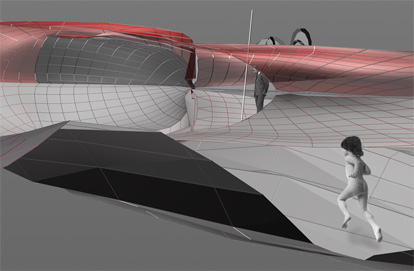
Jessica Lynch, Final year thesis project, 'Inverted Landscape', view into pavillion.
At the beginning of this paper I referred to the substance within the architectural turn to animation. The case studies above have been explored for the various ways in which this substance is built up through a supple intertwinement of forces. Each presents a politics which depart from regimes of distant instrumentality, the confinements of standardisation and rigid identities. They cast off such heavy shadows through an animated politics that enables the affirmation of potential and the power to be affected. The turn of architectural attention to the animate is a substantial twist that cannot be reduced to opportunism in the face of new technologies such as advanced animation software. It is a twist impelled by shifts and bends in the fibres of social, political assemblages. But this is not a shift from one posture to another, it is a movement that adheres only to movement: movement that gathers power through the capacity to operate through supple transformation and complex synthesis; through the will to animation.
Pia Ednie-Brown
Footnotes
1. Gilles Deleuze, Nietzche and Philosophy, Hugh Tomlinson (trans), Athlone Press (London), 1983, p. 4.
2. For example, such phenomena can be found operating within the investigative concerns of practices such as those of dECOi, NOX, Mark Burry, Tom Kovac, Greg Lynn and Asymptote.
3. Gilles Deleuze, Nietzche and Philosophy, op cit, p. 4.
4. For a more detailed exploration of this concept of the 'materiality of affect' see: Pia Ednie-Brown, 'Falling into the Surface', Hypersurface Architecture II, Stephen Perrella (ed), Architectural Design Academy Editions, vol 69, no. 9-10, 1999.
5. Nietzsche, quoted by Gilles Deleuze, Nietzche and Philosophy, op cit, p. 63.
7. As Deleuze writes: "There are things that the higher man does not know how to do: to laugh, to play and to dance. To laugh is to affirm life, even the suffering in life. To play is to affirm chance and the necessity of chance. To dance is to affirm becoming and the being of becoming." Nietzche and Philosophy, op cit, p. 170.
8. "As Guattari never tired of saying, and this essay has just as tirelessly repeated, it is about expression as differential mutual emergence. Autopoiesis." Brian Massumi, '(Involuntary Afterward)', Deleuze, Guattari and the Philosophy of Expression, Brian Massumi (ed), The Canadian Review of Comparative Literature, Vol 24 No 3 , 1998. [http://www.anu.edu.au/HRC/first_and_last/works/crclintro.htm]
9. "The form of encounter we extract is not a "form" as we would normally think of one. It is not static. It is a dynamism, composed of a number of interacting vectors. The kind of 'unity' it has in no way vitiates that multiplicity–it is precisely an interaction between a multiplicity of terms, an interrelation of relations, an integration of disparate elements. It is a diagram of the process of becoming." (my emphasis) Brian Massumi, A user's guide to Capitalism and Schizophrenia. Deviations from Deleuze and Guattari, The MIT Press (Cambridge, Massachussets), 1992, p.14.
10. This might suggest a 'dematerialisation' of texture/substance, which would be misleading. The claim is that materiality is never simply located in the static life of materials as it operates more powerfully in the relations between them (and other forces). This relational 'materiality of affect' is inseparable from all aspects of physical actualisation (ie. it does not replace the commonly visible, but expands it).
11. Gilles Deleuze, Nietzche and Philosophy, op cit, p. 62.
12. Peter Eisenman, Diagram Diaries, Thames and Hudson (London), 1999, p. 43.
13. Gilles Deleuze, 'Postscript on Control Societies', Negotiations, Martin Joughin (trans), Columbia University Press (New York), 1995,p. 179.
17. Peter Eisenman, Diagram Diaries, op cit, p. 207.
19. Nietzche, Thus Spoke Zarathustra, quoted in Gilles Deleuze, Neitzche and Philosophy, op cit, p. 171.
21. Brian Massumi, '(Involuntary Afterward)', op cit.
22. Trait elementaire de geometrie a quatre dimensions, Gauthiers-Villars, Paris, 1903.
23. Jessica Lynch, final design thesis statement, November, 2000.
This website has been archived and is no longer maintained.